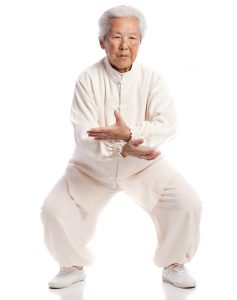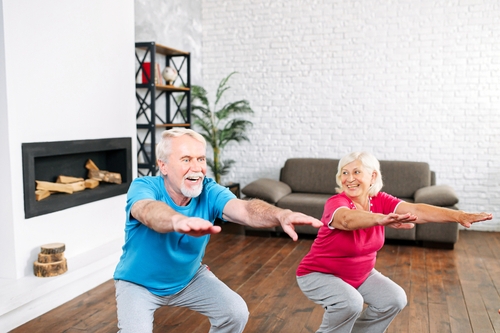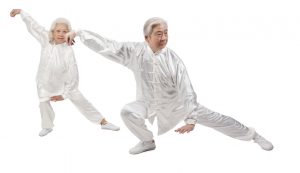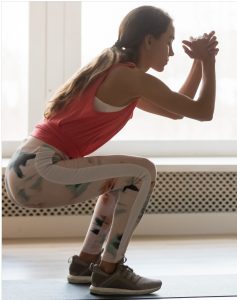Kua Squats May Hold Off Dementia
Evidence is beginning to show that long term practice of T’ai Chi can affect brain structure and function, possibly helping to stave off cognitive decline and dementia as we age.(1)
But, how does it do this? One way is by increasing blood flow to the brain. Increased cerebral blood flow supports the growth of new blood vessels, which, in turn, support the growth of new brain neurons. (2)
Additionally, when combined with mental activity, for example the memorization of the T’ai Chi postures, the increased blood flow supports the development of all the areas of the brain, including the ones linking the right and left hemispheres and the ones supporting the hippocampus and the memory. (3)
Leg Strength is Linked to Brain Strength
Claire Steves, in the journal, Gerontology notes,
“By promoting leg strength in your exercise habits, you are affecting the largest muscle in your body. Improving leg strength improves the flow of blood into the brain, which improves brain function. In a study of twins, we find consistent and strong evidence that increased leg power at baseline was associated with improved cognitive aging over the following 10 years. Also, increased leg power within twin pairs was associated with bigger brain volumes and greater brain activation on functional MRI studies after 12 years.“ (4)
Enter “Squats”
According to the research published by Dr. Damian Bailey, Professor of Physiology and Biochemistry and head of the Neurovascular Research Unit at the University of South Wales:
“The alternating increasing blood flow and decreasing blood flow when doing squats stimulates the interior of the blood vessels to produce neuron growth factors. The brain responds to the “high” and “low” blood pressure changes by growing new neurons and increasing the number of nerve synapses, as well as the size of areas such as the hippocampus.
What we have identified is that three to five minutes of squat stands three times a week is even more effective in terms of how the brain is adapting and responding to that exercise than steady-state exercise. Repeated squat stands, which swing blood flow up to and down from the brain, really help drive the flow of blood to the brain and optimizes the response, selectively targeting brain adaptation over the long-term. “(5)
Do an Internet search for “squats” and you’ll find many variations–Asian Squats, Jump-Squats, Frog Squats, Sissy Squats, Pistol Squats, and the list goes on. Each variation may work slightly different muscles, but they all work the quadriceps and glutes. In a squat of any sort, the core (abdominal) muscles and the muscles on the sides of the knees become involved.
Since we are interested in T’ai Chi, let’s look at Kua Squats (aka, “Kwa Squats”).
Kua Squats

What is a “Kua Squat?” The Kua Squat is a T’ai Chi squat. The feet remain flat, the back is kept straight, the chin is tucked slightly (helping to keep the back and lower back straight), the lower back (mingmen) is relaxed and released, and the tailbone sinks. The knees are bent slightly, but not extended over the toes. The shoulders are aligned with the back of the knees and not pushed forward. At its depth, the thighs are parallel to the floor. This is not the “Asian Squat”, in which the femur actually points to the ground. Arms can hang at the side or extend in front for balance.
Squats abound in T’ai Chi and Qi Gong. Look at the picture of the Eight Brocades…how many squats do you see?
How about “Snake Creeps Down?’
How to do Kua Squats
- Stand with feet parallel, at least hips width apart.
- Open the Kua (hip joint, not waist), bend at the Kua.
- Fold from the kua while releasing the knee hinge (bend from the back of the knees). The knee remains over the foot (behind the toes) and vertical.
- Do not think of the knees, just release, while letting the straight back slide down. Keep the knees over the toes, being careful not to pronate them.
- Push the buttocks out as if about to sit on a stool.
- Relax the back, relax the knee, fold down, pushing the tail bone (buttocks) out. Sit into the posture.
- Tuck the chin slightly to keep the back straight and relieve tension on the lower back. If you have gotten to this point, tucking your chin slightly will release the sides of your lower back.
- The objective of the Kua Squat is to hover the femur (thigh) bone parallel to the floor.
- Hold for a few seconds and slowly rise to standing posture.
A Perfect Kua Squat!
This woman is demonstrating a perfect Tai Chi/Qi Gong Kua Squat.
- She is relaxed. Notice her shoulders are relaxed and down.
- Her back is straight.
- She is tucking her chin slightly to straighten her neck, and her whole back straightens.
- Her tailbone is pointed down, relieving strain on her lower back.
- Her knees are not extended beyond her toes.
- Her thighs are parallel to the floor.
- Her shoulders are aligned with her heels and inner knees.
- Her feet are flat on the floor. She is resting on her heels.
Tips for Kua Squats
- Hold onto a doorknob/door-frame as you squat to help keep your back alignment straight.
- Start from standing with your knees at the edge of a chair seat. As you squat, if the chair moves forward, your knees are moving forward and you are pushing energy into them. In the Kua Squat, we are using the knees as hinges only. Think of relaxing and releasing the front of the knees while allowing the backsides to fold downwards.
- The goal is to have your femur (thigh bone) parallel to the floor, no lower.
- Feet remain flat on the floor. Do not raise the heels; sink into them.
- CAUTION! Start slowly, going only as low as is comfortable. Over zealousness, can easily result in knee injury!
References:
(2) 3 Profound Impacts Exercise Has On the Brain
(3) Tai Chi increases brain size, benefits cognition in randomized controlled trial of Chinese elderly
(5) Dr. Damian Bailey, “The Best Exercises to Boost Blood Flow to Your Brain”




